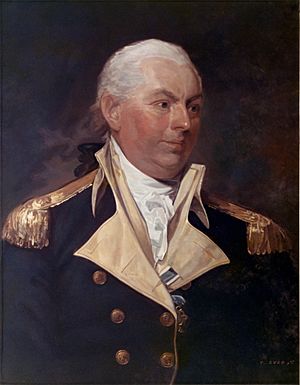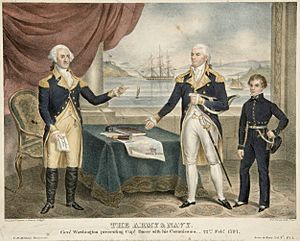John Barry (naval officer) facts for kids
Quick facts for kids
John Barry
|
|
|---|---|

A 1972 repaint by V. Zveg of an 1801 portrait by Gilbert Stuart
|
|
| Born | March 25, 1745 Tacumshane, County Wexford, Ireland |
| Died | September 13, 1803 (aged 58) Philadelphia, Pennsylvania, U.S. |
| Buried | |
| Allegiance | United States of America |
| Service/ |
|
| Years of service | 1776–1783, 1797–1803 |
| Rank | |
| Battles/wars | American Revolutionary War
|
John Barry (born March 25, 1745 – died September 13, 1803) was an important Irish-American naval officer. He served in the Continental Navy during the American Revolutionary War. Later, he joined the United States Navy. Many people call him "The Father of the American Navy." He was one of the first captains in the Continental Navy.
After the war, John Barry became the first officer to be officially commissioned in the U.S. Navy. President George Washington gave him the rank of Commodore in 1797.
Contents
Early Life in Ireland
John Barry was born on March 25, 1745. His family lived in Ballysampson, County Wexford, Ireland. They were a Catholic family. When his family had to leave their home, they moved to Rosslare. His uncle worked there as a fisherman. From a young age, John Barry decided he wanted to be a sailor. He started his career as a cabin boy on a ship.
John Barry became a captain in the Continental Navy on March 14, 1776. John Hancock, who was the president of the Continental Congress, signed his commission. Barry was a very religious man. He would start each day at sea by reading from the Bible. He cared a lot about his crew and made sure they had enough food and supplies.
During his time in the navy, Barry commanded several U.S. warships. These included the Delaware, Lexington, Raleigh, Alliance, and United States.
Commanding the Lexington
Captain Barry took command of the ship USS Lexington on December 7, 1775. This ship had 14 guns. It was the very first ship commissioned by the Continental Congress. The Lexington set sail on March 31, 1776.
On April 7, 1776, near the Capes of Virginia, he met a British ship called the Edward. This ship was a "tender," meaning it supported a larger warship. After a tough fight that lasted over an hour, Barry captured the Edward. He brought it back to Philadelphia.
Later, on June 28, a ship named Nancy arrived. It was carrying 386 barrels of gunpowder. The Nancy got stuck while trying to avoid a British ship. Barry quickly ordered most of the gunpowder to be taken ashore at night. He left only 100 barrels on the Nancy. He also left a special fuse inside the ship. Just as British sailors boarded the Nancy, the fuse caused the gunpowder to explode. This event is known as the Battle of Turtle Gut Inlet.
Barry stayed in command of the Lexington until October 18, 1776. During this time, he captured several other enemy ships.
Commanding the Delaware
In 1777, Barry commanded the ship USS Delaware. This ship was a "brig," a type of sailing ship. It sailed under a "letter of marque." This meant it was allowed to capture British ships in the Delaware River.
Commanding the Raleigh
In 1778, Barry took command of USS Raleigh. He captured three enemy ships with the Raleigh. However, on September 27, 1778, his ship ran aground during a battle. His crew had to sink the ship on purpose to prevent the British from getting it. But the British were able to raise it and use it in their own navy.
Barry also created a "signal book" in 1780. This book helped ships communicate better when they were sailing together.
Commanding the Alliance
On May 29, 1781, Barry was badly hurt while commanding the Alliance. His ship was capturing two British ships, HMS Atalanta and Trepassey.
Barry and his crew on the USS Alliance fought and won the very last naval battle of the American Revolution. This happened on March 10, 1783, about 140 miles south of Cape Canaveral.
Becoming a Commodore
On February 22, 1797, President George Washington gave John Barry Commission Number 1. This made him the first officer to be officially commissioned in the U.S. Navy. His new title was "Commodore." This also made him the first "flag officer" in the American navy. A flag officer is a high-ranking officer, like an admiral.
Commanding the United States
After the U.S. Navy was officially created, Barry was named its senior captain. He commanded the frigate United States. This was during a time of tension with France, known as the Quasi-War. His ship helped transport important people to France to try and make peace.
John Barry's last day of active duty was March 6, 1801. He brought the USS United States into port. He remained the head of the Navy until he passed away.
Later Life and Death
John Barry died on September 13, 1803, in Philadelphia. He passed away from asthma. He was buried in the graveyard of St. Mary's Roman Catholic Church. John Barry did not have any children of his own. However, he helped raise his nephews, Patrick and Michael Hayes. They were the children of his sister, Eleanor, who had passed away.
Personal Life
John Barry married Mary Cleary on October 24, 1768. She died in 1774. On July 7, 1777, he married Sarah Austin. She was the daughter of Samuel Austin and Sarah Keen.
Commemorations
John Barry is remembered in many ways across the United States and Ireland:
- A U.S. Revenue Cutter ship was named Commodore Barry.
- Commodore Barry Park in Brooklyn, New York, is named after him. It is the oldest park in that area.
- Four different U.S. Navy ships have been named after him:
- USS Barry (DD-2) (1902–1920)
- USS Barry (DD-248) (1921–1945)
- USS Barry (DD-933) (1956–1983)
- USS Barry (DDG-52) (1992–present)
- The Commodore Barry Bridge crosses the Delaware River. It connects Chester, Pennsylvania, to Bridgeport, New Jersey.
- There is a John Barry Hall at Villanova University.
- Several schools are named after him, including Commodore John Barry Elementary Schools in Philadelphia and Chicago.
- September 13 is celebrated as Commodore John Barry Day in New Jersey public schools.
- Many plaques and monuments honor him, including one in Franklin Square in Washington, D.C.
- A large statue of Barry stands in front of Independence Hall in Philadelphia.
- A statue of Barry also overlooks the Crescent Quay in Wexford town in Ireland. The United States gave this statue to Ireland.
Images for kids
-
Statue in Independence Hall
-
John F. Kennedy visiting the John Barry Memorial at Crescent Quay in Wexford, Ireland
-
Barry and John Paul Jones on a U.S. postage stamp







